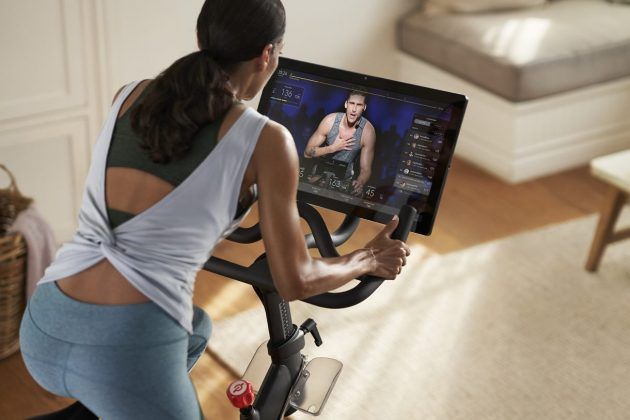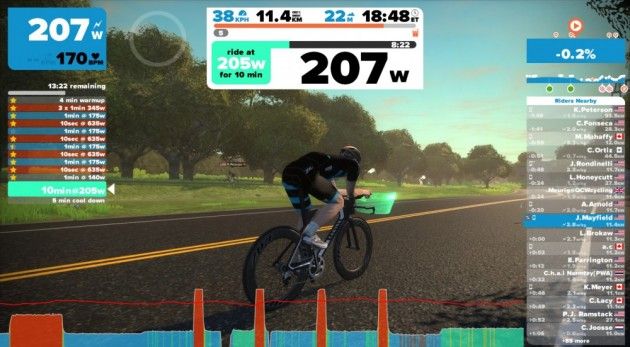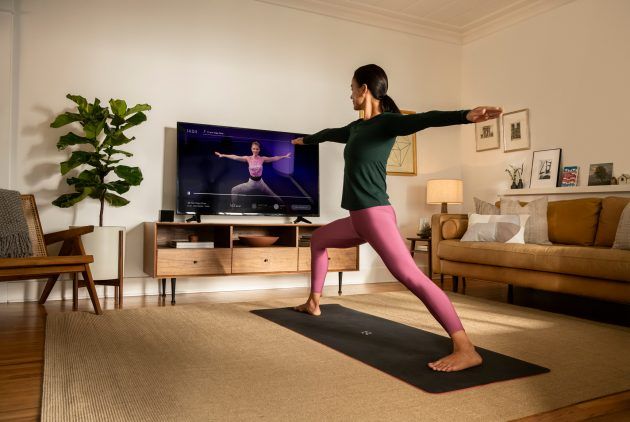Zwift vs Peloton: Which is best for your at-home workouts?
- (opens in new tab)
- (opens in new tab)
- (opens in new tab)
- Sign up to our newsletter Newsletter


Indoor training at home is becoming increasingly popular as more platforms, including Zwift and Peloton, offer diverse and exciting ways to stay engaged with workouts and achieve fitness gains.
Time constraints, a training plan or the weather may force you to drip sweat onto your floorboards as you smash a session indoors, and completing a workout in the comfort of your home has numerous benefits.
For one, cycling indoors gives you more control: it is easier to complete set intervals and it's possible to push harder since there's no need to worry about traffic or potholes.
Zwift has certainly become the trusty companion of many a cyclist for gruelling turbo sessions and racing, especially since lockdown restricted our outdoor riding. E-racing, meanwhile, has grown the platform to even greater levels of popularity.
But the Peloton app has been somewhat ignored by our cycling community. Perhaps its advertising as a disco spin class scared us away - but we shouldn't let that detract us from the truth that there's a lot more to the app than we've given it credit for.
We compare the features of Zwift and Peloton, see how they stack up, and help you understand which is best for you and your goals.
What is Zwift?
Why you can trust Cycling Weekly Our expert reviewers spend hours testing and comparing products and services so you can choose the best for you. Find out more about how we test.

Zwift is a turbo trainer game that lets you ride with other cyclists in an online, virtual environment by hooking up your trainer. For £12.99 a month you can pedal along the virtual roads at any time of the day to fit your schedule.
Group workout rides and races are scheduled throughout the day (and night), and these cater for all fitness levels. Cycling Weekly has even got in on the act too, offering a weekly 10-mile trial.
>>>: Everything you need to know about Zwift
Stuck in your at-home pain cave is certainly made more interesting by navigating around Zwift’s nine maps, which include: London, New York City, Richmond, Harrogate, Innsbruck, Paris and Zwift’s very own Watopia world. There are flat and hillier, short and longer, options amongst these and you can collect badges for completing each route. There’s also badges for other achievements such as completing 100 miles in one indoor ride or smashing 1,000 watts in a sprint.
>> Best Zwift screen set up: TV vs laptop vs tablet vs phone
Structured training is made simple on Zwift as the platform’s workout builder allows you or your coach to construct your own sessions. Alternatively, you can access workouts designed by professional coaches. There’s also the group workout mode, where all riders train at the same intensity based on a percentage of their FTP.
For a truly immersive riding experience on Zwift, a smart turbo trainer such as the Wahoo Kickr and Tacx Neo 2T - which have built-in variable resistance - can be connected to the platform. If you select ERG mode, when your on-screen avatar is riding uphill the resistance on your trainer will increase, making it harder to pedal, and vice-versa on downhill sections. This will create the sensation you are actually cycling around the virtual world and can make training much more engaging.
>> Best smart turbo trainers reviewed
Happily, is also possible to ride on Zwift if you have a tight budget. A standard turbo trainer can be paired with a ANT+ or Bluetooth speed and cadence sensor. Zwift translates this speed into watts using an estimated power curve.
Another cheaper alternative is pairing a standard turbo with an external power meter such as a PowerTap G2 rear hub or 4iiii’s Precision left-side crank - these will give you reliable power data so you’ll only miss out on the variable resistance.
What is Peloton?

A common misconception is that Peloton is just a pricey exercise bike. Well you’re partially right, the spin-style bike does sell at £1990. But the company also has an affordable workout app that can boost your fitness at only £12.99 a month. You don't need the Peloton bike to use the app, plus you can get a 30 day free trial before you fully commit.
>>>: Peloton indoor training bike review
The Peloton app offers a variety of live classes daily that cover all aspects of fitness. As well as cycling workouts, you can dabble in yoga, stretching, meditation, strength, HIIT cardio and running workouts. With the classes’ upbeat tunes and Peloton’s experienced instructors leading the workouts, you feel as though you’ve been transported to a gym class environment. The instructors are there with you, providing encouraging guidance with clear instructions while you push yourself to your limits.
Instructors often introduce ways to tailor each workout to everyone’s own desired difficulty level, meaning it’s never too easy or too hard. There’s also plenty of interaction so you really feel like you’re in it together. As cringe as that sounds, it really can make the difference between giving up or seeing something through.
Scrolling through the schedule of classes on the app you will notice the instructor of each class is prominently listed - choosing a class is not only about the sweaty stuff inside but, more importantly, about who can lead you to achieve your fitness targets.
Live classes can give you a commitment to follow through on and seeing the instructor on the screen in front of you gives a very real human connection. Exercising at home no longer needs to be done in isolation.
However if a live class isn’t taking place at a time which suits your schedule, you can watch and follow an archived video workout, of which there are currently over 12,000 of. The app is immensely popular and with good reason.
Zwift v Peloton
Interaction
Communicating with other riders on Zwift can be done via Zwift’s companion app, which works like instant messaging. Invest in a phone mount for your handlebars and you can type away while you keep on turning the pedals. If you are participating in a group ride the ride leader’s messages will also appear large-scale on your main screen. Encouraging comments pop up when you need them and will keep you engaged.
However, often the rider leader is replying to the messages of other riders on the companion app, which can be somewhat annoying if you don’t have the app and aren’t following the conversation (as you only see one-side). But there’s an easy solution to this, download the free app and join in with the chit chat that will help distract you from the riding grind.
Unlike Zwift where you only see the avatar of the ride leader, you can hear the voice and see the face of Peloton’s instructors as you exercise. This gives you real-time motivation and heartening feedback. A human connection when training should not be undervalued, and Peloton manage to make you feel like you’re in a packed studio which is impressive given that your dirty laundry and plates are mere metres away.
Quality of cycling workouts

No doubt, Zwift offers high quality workouts that are beneficial for cyclists, from beginners to regular racers alike. The best riders in the world use Zwift, so we tend to think that if a Tour de France winner approves of something, it's good enough for us.
There’s a large number of workouts to choose from and full training plans to follow that are designed by the likes of former Italian national time-trial champion Marco Pinotti and former American professional Chris Carmichael.
>>>: Four of the best indoor cycling sessions for turbo training
Workouts vary in duration and training focus, as well as being very easy to follow. The overall structure of your session is visible on the left hand of the screen. At the top sits all the details of the target watts of your interval, time left and your current power output. The latter turns red if you are under or over the set effort, which is a handy indicator to stay on track.
Peloton’s offerings are less technical and resemble gym spin classes and they can provide a high-intensity workout which will certainly see you finish a sweaty mess. With the upbeat atmosphere and the right instructor, this kind of workout will allow you to push yourself deeper than in other environments.
It is very different from outdoor riding but you’ll improve in specific areas such as core strength and leg speed.
>>>: Benefits of spin cycling explained
Variety

Key to sticking with any kind of training is a maintained level of interest. Variety is one way of achieving this and both of these fitness platforms offer this in contrasting ways.
Zwift has so many routes to choose from and worlds to explore, it’ll take you a considerable amount of time to collect all the badges by completing them all. Quite a few of these can be an fulfilling challenge, such as the Prudential Ride London Full course which is 173.3km and has 2623m of climbing. But then again, how interesting is it really staring at a virtual world. It pretty much all looks the same anyway.
There are also plenty of events to ride with others in, but with the focus limited to cycling workouts - unless you have a compatible treadmill which will open up to running options - other aspects of fitness are somewhat neglected.
Peloton, on the other hand, helps you refocus your mind alongside training your body with their yoga and meditation classes. Mixing between their array of classes boosts your fitness in a myriad of different ways and keeps training fresh and exciting.
The benefits of supplementing your on-bike training sessions with alternative workouts has been recognised as an effective method of avoiding injury.
>>>: Bulletproof your body with strength and conditioning training to stay injury free
Zwift vs Peloton? The verdict
When you delve into these platforms, you can see that what they excel at, and offer, are very different things. It’s not about choosing which software has the best cycling workouts, because you will undoubtedly gain fitness benefits from both, it is more about what other features are more suited to you and your needs.
If smashing it against riders from across the world in cycling races is your thing and data is everything, then pick Zwift. But if you have a holistic vision of fitness and want to practice yoga, develop a regular stretching routine and you grow best from human guidance, Peloton is the unmistakable choice.

Thank you for reading 10 articles this month* Join now for unlimited access
Enjoy your first month for just £1 / $1 / €1
*Read 5 free articles per month without a subscription

Join now for unlimited access
Try first month for just £1 / $1 / €1

I’ve been hooked on bikes ever since the age of 12 and my first lap of the Hillingdon Cycle Circuit in the bright yellow kit of the Hillingdon Slipstreamers. For a time, my cycling life centred around racing road and track.
But that’s since broadened to include multiday two-wheeled, one-sleeping-bag adventures over whatever terrain I happen to meet - with a two-week bikepacking trip from Budapest into the mountains of Slovakia being just the latest.
I still enjoy lining up on a start line, though, racing the British Gravel Championships and finding myself on the podium at the enduro-style gravel event, Gritfest in 2022.
Height: 177cm
Weight: 60–63kg
-
-
 High-end bikes still in demand says Giant, as it announces 12.5% revenue increase
High-end bikes still in demand says Giant, as it announces 12.5% revenue increaseBut like much of the industry the Taiwanese manufacturer is also experiencing a surplus of low to mid priced stock
By James Shrubsall • Published
-
 Milan-San Remo 2023: Route and start list
Milan-San Remo 2023: Route and start listAll you need to know about the first Monument of the 2023 season
By Ryan Dabbs • Published

